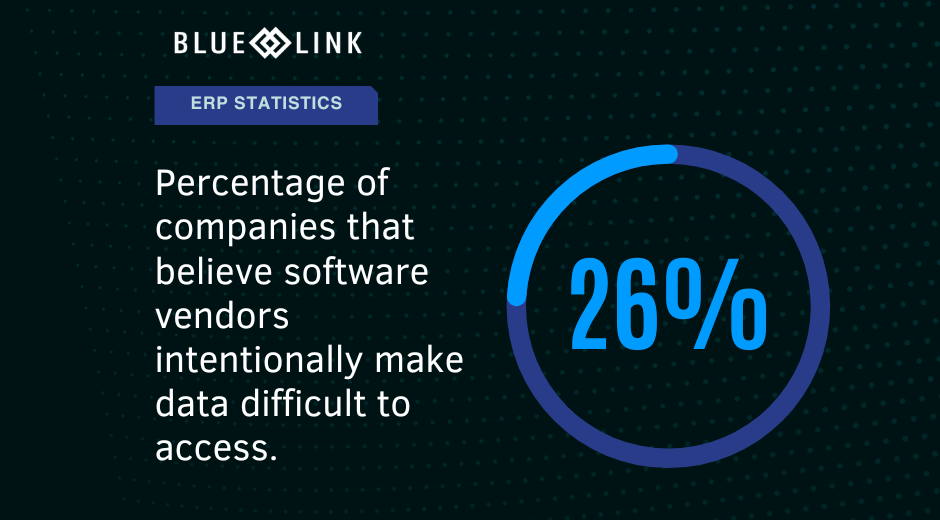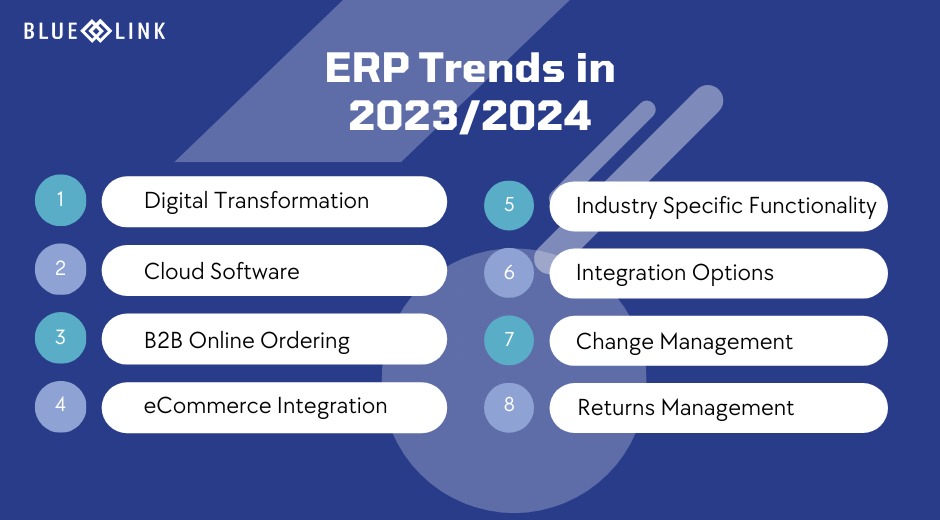ERP systems continue to grow in popularity with all types of businesses from SMBs to multinational companies. An ERP solution helps your organization to streamline its operations and connect all of its processes to improve efficiency. This article will go over some of the most relevant ERP statistics and trends that will help you understand how businesses perceive ERP software. Understanding how executives and ERP stakeholders view ERP software will help you gauge the value of an ERP system for your company.
70 ERP Statistics and Trends
ERP Market Share (Statistics)
Statistics show that the ERP market is expanding, and the rise of ERP solutions is growing as time goes on.
- The ERP Software Market is expected to be worth $300 billion by 2027.
- The global ERP market has grown by 8% since 2022 across geographies, company revenues, and sizes.
- 8.7% of companies that use ERP systems are distributors and/or wholesalers.
- 1.4 million companies are expected to spend $183 billion on ERP software in 2024.
- ERP solutions represent 16.8% of global software spend or $171.7 billion out of $1.02 trillion in 2023.
- ERP software makes up 5% of total IT spend.
ERP Implementation Statistics
The implementation stage is the most critical phase when adopting a new ERP system. The implementation process, however, can be challenging, and statistics show us the many challenges and preferences that companies have when implementing ERP software.
- The big-bang approach to data migration is less common than phased approaches as only 20.8% of organizations use the big bang approach in data migration.
- 58.8% of businesses use some sort of phased approach in data migration.
- 20.8% of businesses use a hybrid approach in data migration.
- SMB’s (under $100 million in revenue) were slower in implementing their ERP than mid-sized businesses (between $100 million to $250 million in revenue), possibly due to less resources and expertise.
- More than a quarter of organizations implemented software without any customization.
- 51% of organizations chose a SaaS deployment model for their ERP as opposed to a hosted or managed services model.
- 38% of ERP testing is done by QA teams.
- 31% of businesses believe integration testing is the biggest challenge they face in ERP testing.
- 79% of ERP stakeholders say that testing is an area their business has increased investment in compared to last year.
- 22% of businesses believe data migration and validation is the biggest challenge they face in ERP testing.
- 68% of stakeholders say financial management is the most important area to test thoroughly.
- 37% of stakeholders believe that the most important reason to test during a migration is to ensure security and compliance.
- 31% of stakeholders believe that the most important reason to test during a migration is to ensure user experience is optimal.
- 49% of companies went live according to schedule.
- 27% of companies went live a little later than scheduled.
- 11% of companies failed to go live as scheduled.
- 13% of companies went live sooner than expected.
- The top two reasons for lack of success in an ERP Implementation are inadequate quality of testing and inadequate business process re-engineering.
- Poor quality software is the least stated reason for lack of implementation success.
ERP ROI Statistics
The ROI that ERP solutions bring is more important than ever for companies, possibly due to a difficult economy with rising inflation and interest rates. Companies have specific goals in mind and want their ERP system to reach those goals.
- 74% of ERP stakeholders say that ROI has become important to them in 2023. In 2022, only 43% felt the same way.
- 46% of businesses believe that business cost savings is a “top 3” most important goal for ERP.
- 12% of businesses believe that regulatory compliance is a “top 3” most important goal for ERP.
- 46% of businesses believe that improving selected performance metrics is a “top 3” most important goal for ERP
- 36% of businesses believe that supporting growth is a “top 3” most important goal for ERP.
- The biggest area that ERP has produced ROI for companies is reduced IT costs (40% of businesses).
- 9% believe that their ERP has had no ROI benefits to their company.
- 38% believe that their ERP has helped ROI through reduced inventory levels.
- 71% of businesses hope to use their ERP data to learn how to make their operations more efficient.
- 71% of businesses want to use ERP data for predictive analytics or to forecast what will happen.
- 63% of businesses want to use ERP data for descriptive analytics or to understand what happened.
- 71% of companies believe that decisions are delayed if ERP data is unavailable.
- 69% of companies believe that data analysis is delayed if ERP data is unavailable.
- Only 1% of companies believe that there are no negative ramifications if ERP data is unavailable.
- Only 1% of businesses believe that nothing is holding them back from leveraging their data to achieve business goals.
- 51% of businesses believe that integration problems hold them back from leveraging their data to achieve business goals.
- 46% of businesses believe that lack of in-house skills (expertise) is holding them back from leveraging their data to achieve business goals.
Business Process Automation Statistics
ERP software seeks to automate business processes, especially processes that occur within the warehouse. Here are some statistics that will make you think about the processes you want to automate using your ERP system.
- Order-picking accounts for 50% of the time spent travelling in the warehouse.
- 75% say returns management is one of the top five most important logistics services
- 37% of businesses lack confidence in a carrier’s ability to meet customer demands.
- 45% of businesses are using strategic tactics to position inventory across multiple fulfillment centers, including the use of a local delivery service.
- 56% of businesses across all verticals listed returns management software integrations as a must-have in their logistics operations.
- One-third of companies still struggle to meet customer delivery demands
- 8.7% of organizations did not improve their business processes through their ERP system.
- 38% of companies are planning to add more SKUs and barcode scanners for inventory accuracy.
Cloud Technology Statistics
Cloud software is becoming the norm over on-premises solutions all throughout tech, and ERP software is no exception.
- Cost is the least common reason for not choosing cloud as only 6.2% of companies cite cost as the reason they didn’t choose cloud.
- 96% of companies believe that most of their data will be cloud-based in 5 years.
- 76% of businesses have moved or started to move on-premises ERP to the Cloud.
- 83% of businesses are using more SaaS apps in 2023 versus 2022
- The primary motivation for 39% of businesses to move to the Cloud is to take advantage of better business processes.
- The primary motivation for 32% of businesses to move to the Cloud is Scalability and ROI.
ERP Data Statistics
ERP systems are used to easily manage and centralize a company’s data. These statistics may surprise you as many struggles with accessing their ERP data and blame their vendor for making ERP data difficult to access. Consequently, companies cannot make good business decisions from having stale data. Only some businesses have access to real-time data.
- 65% of businesses believe that accessing their ERP data is difficult.
- 99% of companies face several data-related challenges because of complexity and integration.
- 78% of companies believe that software vendors intentionally make data difficult to access.
- 82% of companies work with stale data.
- 85% of companies believe that stale data leads to bad business decisions.
- Only 23% of companies have access to real-time data.
ERP Trends
As it pertains to ERP software, many new trends are growing stronger heading into 2024. Here are some of the biggest ERP trends.
- Digital Transformation: More companies are starting to conduct digital transformations as the global digital transformation market is expected to grow to $1,009.8 billion by 2025. This is more than double of what it was in 2020 at $469.8 billion.
- Returns management: This is becoming more of a priority for companies due to changing consumer expectations and a rise in eCommerce since the start of the pandemic. There were double the amount of retail returns in 2022 compared to 2019 as they increased from $309 billion to $613.94 billion over this 3 year period.
- eCommerce Integration: The rise of eCommerce has also led to businesses focusing more on eCommerce integration with their ERP software. Businesses that previously stayed away from this channel are now gravitating towards it. By 2040, 95% of all purchases are expected to be eCommerce.
- Online Ordering for B2B Companies: ECommerce's rise has also led wholesale distributors and companies that sell to other businesses to adopt online ordering platforms that connect with their ERP systems. 90% of B2B buyers start their buying journey through an online search, so providing a channel through which buyers can purchase online is a golden opportunity.
- Industry-Specific Functionality: In many industries such as food and pharmaceutical distribution, having industry-specific functionality in place is more important than ever due to tightening regulations. In the pharmaceutical world for instance, the DSCSA interoperability deadline is about to pass with a stabilization period that will last until November 2024.
- All-In-One ERP: Businesses nowadays truly want an all-in-one solution with more integration options for their ERP system than ever before. They want the ability to integrate all of their processes into one centralized database to ensure visibility and consistency. This includes connecting their shipping, logistics, warehouse management, eCommerce, sales, and accounting processes.
- Change Management: When adopting a major change such as a new ERP system, companies are bound to deal with members of their organization who oppose the change or are slow to embrace it. In recent years, organizational change is occurring more frequently, making change management more important than ever. In a survey of 1,284 executives, 85% of senior executives stated that they noticed a huge increase in organizational change projects over the past five years.
- Cloud Software: There is an increasing demand for cloud software, with Gartner estimating that worldwide spending on cloud services is expected to reach $678.8 billion in 2024, which is up by 20.4% from 2023 at $563.6 billion.












